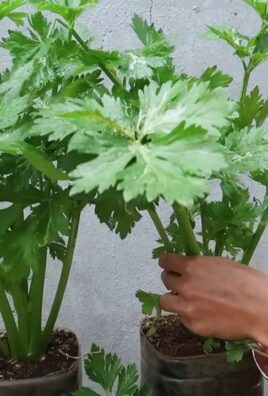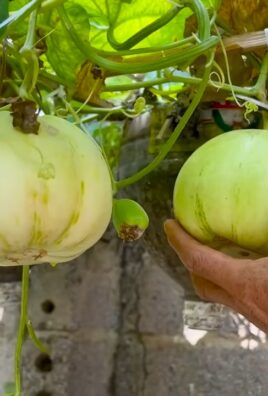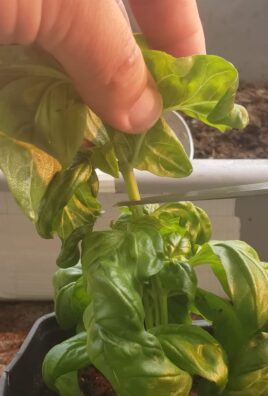Grow Ginger at Home – imagine the satisfaction of snipping off a piece of fresh, zesty ginger root right from your own backyard (or even your kitchen windowsill!). Forget those sad, shriveled pieces at the grocery store; we’re talking vibrant, flavorful ginger, ready whenever you need it. This isn’t just about saving money; it’s about connecting with nature and experiencing the joy of nurturing something from rhizome to harvest.
Ginger, with its fiery kick and incredible health benefits, has been cultivated for thousands of years. Originating in South Asia, it quickly spread across the globe, becoming a staple in traditional medicine and cuisines from India to China to the Caribbean. For centuries, cultures have revered ginger for its digestive properties, anti-inflammatory effects, and its ability to add a unique zing to everything from stir-fries to soothing teas.
But why should *you* learn to grow ginger at home? Well, for starters, commercially grown ginger can sometimes be treated with chemicals. Growing your own ensures you know exactly what’s going into your food. Plus, it’s surprisingly easy! Many people think you need a sprawling garden, but that’s simply not true. With a few simple tricks and a little patience, you can cultivate your own supply of this amazing spice, even in a small apartment. I’m going to share some of my favorite DIY hacks that will have you harvesting fresh ginger in no time. Get ready to unleash your inner gardener and enjoy the delicious rewards!

Growing Ginger at Home: Your Comprehensive DIY Guide
Hey garden friends! Have you ever wondered how you can grow that spicy, healthy ginger you love to use in your tea or curry yourself? I’ll show you how! It’s easier than you think, and it’s a lot of fun to watch your own ginger plants grow and thrive. Let’s get started!
What You Need: The Ingredients for Your Ginger Success
Before we begin, here’s a list of the things you’ll need. Don’t worry, you probably have most of them at home already!
- A piece of ginger root (rhizome): Preferably organic ginger, as conventional ginger is sometimes treated with growth inhibitors. Make sure the root has plump “eyes” (small buds).
- A planter: It should be wide and not too deep, as ginger tends to grow horizontally. A container with a diameter of at least 30 cm is ideal.
- High-quality potting soil: Good drainage is important! I recommend a mix of potting soil, compost, and a bit of perlite or vermiculite for better drainage.
- Water: Clear, clean water for watering.
- A sunny location: Ginger loves warmth and light, but not direct, harsh midday sun.
- A spray bottle (optional): To increase humidity.
- Patience: Ginger takes time to grow!
The Preparation: The Key to Success
Before we put the ginger in the soil, there are a few preparation steps that can make all the difference.
- Prepare the ginger root: If your ginger root has several “eyes,” you can cut it into smaller pieces. Each piece should have at least one or two eyes. Let the cut surfaces air dry for a few days to prevent rot. This is super important!
- Soaking (optional, but recommended): Place the ginger pieces in lukewarm water for a few hours or overnight. This helps to activate the buds and speed up the germination process.
- Prepare the planter: Fill the planter with the potting soil. Leave about 5 cm of space at the top.
The Planting: Now It’s Getting Serious!
Now comes the exciting part: planting the ginger!
- Place the ginger pieces: Lay the ginger pieces on the soil with the eyes facing up. Make sure they are not too close together if you are planting multiple pieces in one container.
- Cover with soil: Cover the ginger pieces with about 2-5 cm of soil. Press the soil down lightly.
- Water: Water the soil thoroughly until it is moist, but not soaked.
The Care: Patience and Attention
Now it’s time to wait and care for it! Ginger needs a little love to grow properly.
- The location: Place the planter in a warm, bright spot, but avoid direct sunlight, especially during the hottest hours of the day. An east or west-facing window is ideal.
- Watering: Keep the soil moist, but not wet. Water when the top layer of soil feels dry. Avoid waterlogging, as this can lead to rot.
- Humidity: Ginger loves high humidity. You can spray the leaves regularly with water or place the planter on a tray with pebbles and water.
- Fertilizing (optional): If you wish, you can fertilize the ginger every few weeks with an organic liquid fertilizer. Be sure to follow the instructions on the packaging.
- The temperature: Ginger grows best at temperatures between 20 and 30 degrees Celsius. Protect it from frost!
The Harvest: The Reward for Your Effort
After about 8-10 months, you can harvest your own ginger!
- The signs: The leaves will turn yellow and begin to wither. This is a sign that the ginger is ripe.
- The harvest: Carefully dig around the plant and lift the ginger root out of the soil.
- The use: You can use the ginger immediately or store it in the refrigerator.
Common Problems and Solutions: Don’t Panic!
Sometimes problems arise, but don’t worry, I’ll help you!
- Rot: If the ginger root is rotting, the soil is likely too wet. Reduce watering and ensure better drainage.
- No germination: If the ginger root doesn’t sprout, it may be because it’s too old or has been treated with growth inhibitors. Try again with a fresh, organic ginger root.
- Pests: Ginger is relatively resistant to pests, but occasionally aphids or spider mites can take hold. Spray the leaves with a solution of water and a little dish soap or use an organic insecticide.
Additional Tips and Tricks: For the Extra Green Thumb
Here are a few more tips that can help you optimize your ginger cultivation:
- Variety selection: There are different varieties of ginger that differ in taste and appearance. Try different types to find your favorite.
- Propagation: You can repeatedly propagate your ginger by dividing the root and replanting the pieces.
- Using the leaves: The leaves of the ginger plant are also edible and have a mild ginger flavor. You can use them in salads or soups.
- Growing outdoors: In warm climates, you can also grow ginger outdoors. Make sure the location is partially shaded and the soil is well-draining.
Overwintering Ginger in a Pot: Here’s How!
If you live in a region with cold winters, you’ll need to overwinter your ginger in a pot.
- Preparation: Before the first frost arrives, cut the leaves of the ginger plant back to a few centimeters.
- Location: Place the pot in a cool, dark, and dry place, e.g., in a cellar or garage. The temperature should ideally be between 10 and 15 degrees Celsius.
- Watering: Water the ginger very sparingly during the winter months, just enough to keep the soil from drying out completely.
- Spring: As soon as temperatures rise again in the spring and the danger of frost is over, you can move the ginger back to a brighter, warmer location and gradually increase watering.
Harvesting and Storing Ginger: How to Keep It Fresh
You can harvest ginger as soon as the plant is about 8-10 months old. The leaves will then turn yellow and begin to wither.
- Harvest: Carefully dig the ginger root out of the soil.
- Cleaning: Remove the soil from the root and wash it thoroughly.
- Storage: There are several ways to store ginger:
- In the refrigerator: Wrap the ginger in a damp paper towel and place it in a plastic bag. It will keep for several weeks this way.
- In the freezer: You can also freeze ginger. Either peel it and cut it into slices or grate it directly while frozen.
- Pickled: Pickled ginger is a delicious and long-lasting option.
I hope…

Conclusion
So, there you have it! Growing ginger at home isn’t just a fun gardening project; it’s a gateway to fresher, more flavorful ginger than you’ll ever find at the grocery store. Imagine the vibrant aroma filling your kitchen as you harvest your own rhizomes, ready to be grated into stir-fries, steeped into soothing teas, or candied for a delightful treat. This DIY trick is a must-try for anyone who appreciates fresh ingredients and enjoys a touch of green in their living space.
But why is this method so compelling? Beyond the sheer satisfaction of nurturing your own food, growing ginger at home offers several distinct advantages. First, you control the growing environment, ensuring your ginger is free from harmful pesticides and herbicides. Second, you can harvest ginger as needed, guaranteeing peak freshness and flavor. Third, it’s incredibly cost-effective in the long run. A single ginger rhizome from the store can yield a continuous supply of ginger for months, even years, to come.
Don’t be afraid to experiment with variations! Try different types of ginger, such as the spicier Chinese ginger or the milder Hawaiian ginger. Consider using different potting mixes to see which yields the best results in your climate. You can even grow ginger in containers of varying sizes to find the perfect balance between space and yield. For a decorative touch, use attractive pots that complement your home décor.
For those who live in colder climates, growing ginger indoors is a fantastic way to bring a touch of the tropics into your home. The lush green foliage adds a vibrant element to any room, and the subtle ginger scent is naturally uplifting. Even if you have limited gardening experience, this project is surprisingly easy and rewarding.
We encourage you to embrace this DIY adventure and discover the joys of growing your own ginger. It’s a simple yet profound way to connect with nature, enhance your culinary creations, and enjoy the unparalleled flavor of homegrown ingredients.
Once you’ve harvested your first batch of homegrown ginger, we’d love to hear about your experience! Share your photos, tips, and stories in the comments below. Let’s create a community of ginger-growing enthusiasts and inspire others to embark on this rewarding journey. What challenges did you face? What successes did you celebrate? Your insights can help others learn and grow, literally and figuratively.
Remember, the key to successful ginger cultivation is patience, proper watering, and a little bit of love. With these ingredients, you’ll be well on your way to enjoying a bountiful harvest of fresh, flavorful ginger right from your own home. So, grab a ginger rhizome, prepare your pot, and get ready to experience the magic of growing your own! This simple **grow ginger at home** method will change the way you think about this amazing spice.
Frequently Asked Questions (FAQ)
1. What kind of ginger should I use to start growing?
You can use ginger from the grocery store, but make sure it’s plump, healthy-looking, and preferably organic. Look for rhizomes with visible “eyes” or buds, as these are the points from which new shoots will emerge. Avoid ginger that is shriveled, moldy, or has been treated with growth inhibitors. Organic ginger is often a safer bet, as it’s less likely to have been treated with chemicals that could prevent sprouting. If you can find ginger specifically sold for planting, that’s even better!
2. How long does it take for ginger to sprout?
Sprouting time can vary depending on factors like temperature, humidity, and the health of the rhizome. Generally, it takes anywhere from 2 to 8 weeks for ginger to sprout. Be patient and keep the soil consistently moist but not waterlogged. Providing warmth, such as placing the pot in a sunny location or using a heat mat, can help speed up the process.
3. What kind of soil is best for growing ginger?
Ginger thrives in well-draining, nutrient-rich soil. A good potting mix for ginger should be loose and airy, allowing for proper root development. You can create your own mix by combining equal parts of potting soil, compost, and perlite or vermiculite. The compost provides essential nutrients, while the perlite or vermiculite improves drainage and aeration. Avoid heavy clay soils, as they can retain too much moisture and lead to root rot.
4. How much sunlight does ginger need?
Ginger prefers partial shade, especially in hot climates. Direct sunlight can scorch the leaves. Ideally, provide ginger with 2-5 hours of indirect sunlight per day. A spot near an east-facing window is often ideal. If you’re growing ginger outdoors, choose a location that receives morning sun and afternoon shade.
5. How often should I water my ginger plant?
Water ginger regularly, keeping the soil consistently moist but not waterlogged. Allow the top inch of soil to dry out slightly between waterings. Overwatering can lead to root rot, so it’s crucial to ensure proper drainage. During the warmer months, you may need to water more frequently than during the cooler months. Check the soil moisture regularly and adjust your watering schedule accordingly.
6. When is the best time to harvest ginger?
You can start harvesting ginger about 8-10 months after planting. The leaves will begin to turn yellow and die back, indicating that the rhizomes are mature. You can harvest the entire plant or simply dig up a portion of the rhizome as needed. To harvest, gently loosen the soil around the plant and carefully lift the rhizome from the ground.
7. Can I grow ginger indoors year-round?
Yes, you can grow ginger indoors year-round, especially if you live in a colder climate. Provide the plant with adequate light, warmth, and humidity. You may need to supplement with artificial light during the winter months. Maintaining consistent temperatures and humidity levels will help ensure healthy growth.
8. What are some common problems when growing ginger, and how can I fix them?
Some common problems include root rot (caused by overwatering), pests (such as aphids or spider mites), and nutrient deficiencies. To prevent root rot, ensure proper drainage and avoid overwatering. If you notice pests, treat the plant with insecticidal soap or neem oil. If the leaves are yellowing or stunted, the plant may be lacking nutrients. Fertilize with a balanced organic fertilizer every few weeks.
9. Can I grow ginger in a container? What size container should I use?
Yes, ginger grows very well in containers. Choose a container that is at least 12 inches deep and wide to allow for adequate root development. Make sure the container has drainage holes to prevent waterlogging. As the ginger plant grows, you may need to repot it into a larger container.
10. How do I store harvested ginger?
Freshly harvested ginger can be stored in the refrigerator for several weeks. Wrap it in a paper towel and place it in a plastic bag to prevent it from drying out. You can also freeze ginger for longer storage. Peel and chop the ginger into small pieces, then freeze it in a single layer on a baking sheet. Once frozen, transfer the ginger to a freezer bag or container. Frozen ginger can be grated directly into recipes without thawing.




Leave a Comment